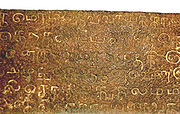
Indian copper plate inscriptions
Encyclopedia



India
India , officially the Republic of India , is a country in South Asia. It is the seventh-largest country by geographical area, the second-most populous country with over 1.2 billion people, and the most populous democracy in the world...
. Prior to their discovery, historians were forced to rely on ambiguous archaeological findings such as religious text of uncertain origin and interpretations of bits of surviving traditions, patched together with travel journals of foreign visitors along with a few stone inscriptions. The discovery of Indian copper plate inscriptions provided a relative abundance of new evidence for use in evolving a chronicle of India's elusive history.
History
Earliest inscriptions on copper tablets were found at Mohenjodaro.Indian copper plate inscriptions (tamarashasana), usually record grants of land or lists of royal lineages carrying the royal seal, a profusion of which have been found in South India. Originally inscriptions were recorded on palm leaves, but when the records were legal documents such as title-deeds they were etched on a cave or temple wall, or more commonly, on copper plates which were then secreted in a safe place such as within the walls or foundation of a temple, or hidden in stone caches in fields. Plates could be used more than once, as when a canceled grant was over-struck with a new inscription. These records were probably in use from the first millennium. The earliest authenticated plates were issued by the Pallava
Pallava
The Pallava dynasty was a Tamil dynasty which ruled the northern Tamil Nadu region and the southern Andhra Pradesh region with their capital at Kanchipuram...
dynasty kings in the 4th century A.D. and are in Tamil
Tamil language
Tamil is a Dravidian language spoken predominantly by Tamil people of the Indian subcontinent. It has official status in the Indian state of Tamil Nadu and in the Indian union territory of Pondicherry. Tamil is also an official language of Sri Lanka and Singapore...
, Prakrit
Prakrit
Prakrit is the name for a group of Middle Indic, Indo-Aryan languages, derived from Old Indic dialects. The word itself has a flexible definition, being defined sometimes as, "original, natural, artless, normal, ordinary, usual", or "vernacular", in contrast to the literary and religious...
although later Sanskrit
Sanskrit
Sanskrit , is a historical Indo-Aryan language and the primary liturgical language of Hinduism, Jainism and Buddhism.Buddhism: besides Pali, see Buddhist Hybrid Sanskrit Today, it is listed as one of the 22 scheduled languages of India and is an official language of the state of Uttarakhand...
was used. An example of early Sanskrit inscription in which Kannada words are used to describe land boundaries, are the Tumbula inscriptions of Western Ganga Dynasty, which have been dated to 444 CE according to a 2004 Indian newspaper report. Rare copper plates from the Gupta
Gupta Empire
The Gupta Empire was an ancient Indian empire which existed approximately from 320 to 550 CE and covered much of the Indian Subcontinent. Founded by Maharaja Sri-Gupta, the dynasty was the model of a classical civilization. The peace and prosperity created under leadership of Guptas enabled the...
period have been found in North India. The use of copper plate inscriptions increased and for several centuries they remained the primary source of legal records.
Most copper plate inscriptions record title-deeds of land-grants made to Brahmanas, individually or collectively. The inscriptions followed a standard formula of identifying the royal donor and his lineage, followed by lengthy honorifics of his history, heroic deeds, and his extraordinary personal traits. After this would follow the details of the grant, including the occasion, the recipient, and the penalties involved if the provisions were disregarded or violated. Although the profusion of complimentary language can be misleading, the discovery of copper plate inscriptions have provided a wealth of material for historians
Tirumala Venkateswara Temple
Tirumala Venkateswara Temple
Tirumala Venkateswara Temple ), is a Hindu temple in the hill town of Tirumala, near Tirupati in the Chittoor district of Andhra Pradesh, South India. It is around from Chennai, from Hyderabad, and from Bangalore....
have a unique collection of about 3000 copper plates on which the Telugu Sankirtans of Tallapaka Annamacharya and his descendants are inscribed.

